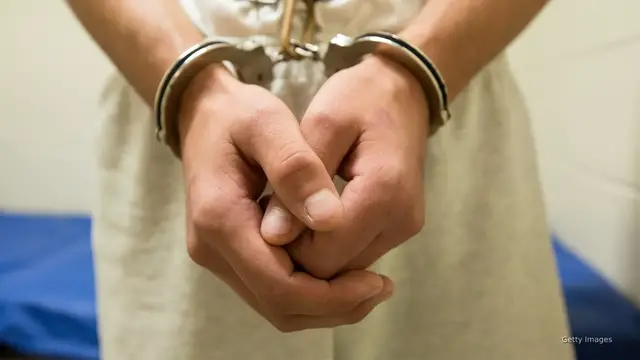The debate over punishing juveniles is back, with calls for harsher penalties. In the 1990s, youth offenders were labeled "super-predators."
Show More Show Less View Video Transcript
0:00
Police say 17-year-old Austin Metcalf was killed by a Frisco ISD student
0:04
Boy accused of shooting a man to death in downtown Austin last night
0:08
They say there had been a brief exchange before the teen pulled the trigger near 3rd and New S's
0:14
Four boys will be charged, one just 11 years old, following a Tuesday night homicide in northwest Omaha
0:21
It's cases like these reigniting a decades-old debate. Should juveniles face harsher penalties for serious crimes
0:30
Experts say picture a pendulum. Three decades ago, society saw teens who committed violent crimes as a new breed of offenders
0:40
They are often the kinds of kids that are called super predators. No conscience, no empathy
0:46
A narrative media outlets contributed to because of the widely used term
0:51
The pendulum swung hard toward tough on crime laws, putting kids in courtrooms being tried as adults
0:57
Then came a shift. Advocates pushed back, fighting for reform. The rhetoric then centered around prison as college for criminals, resulting in teenagers entering as juveniles and exiting ready to commit more serious crimes
1:11
The goal, get kids help, not handcuffs. But now that pendulum is swinging again back toward punishment
1:18
In the past couple of years, there has been a resurgence, at least kind of in the public narrative and some media and some legislators, more along the lines of that kind of super predator idea, right
1:32
Along the idea of there's something wrong with kids, we need to punish them
1:36
Policy strategist Amy Barore uses her role at the nonprofit Golt Center to drive the conversation toward rehabilitation, focusing on why youth commit crimes, not just that they do
1:48
It's like the ecosystem around a child that children who don't get involved in the court system have, right
1:55
And so when you look at neighborhoods and families and areas where they don't have significant legal system involvement
2:04
those are places where neighborhoods are safe and schools are well-funded and parents have jobs that pay enough to keep a roof over their heads and food in their bellies
2:13
Co-founder and Chief Legal Officer Marsha Levick of the Juvenile Law Center says race still plays a major role in how the system works
2:21
including who ends up in correctional facilities across the country. It was largely populated by black and brown children 50 years ago It still largely populated by black and brown children She says for the last 50 years it been the same fight both inside and outside the justice system
2:40
to end racial disparities that continue to shape outcomes for youth of color
2:45
We know year after year, decade over decade, that the police are present in communities of color
2:52
and kids get picked up and arrested and stopped and searched for things
2:58
and under circumstances that don't happen in white communities. And unsurprisingly, that means that more of those kids end up in the justice system
3:08
Juvenile justice advocates call it anecdotal, blips of youth crime that's used to push tougher laws and harsher penalties
3:15
But some lawmakers say it's part of a culture of non-consequence and are pushing to roll back previous reforms
3:22
Louisiana, a state long known for being tough on crime, has already made that shift
3:26
In 2023, Governor Jeff Landry signed a crime package into law, including a measure that treats 17-year-olds accused of a crime as adults under the law
3:37
Just within the last month or two, they had an election, a referendum on constitutional amendments that would have gone even further in allowing young people to be tried as adults
3:49
And they were rejected by the Louisiana electorate by two to one. North Carolina Republicans passed similar legislation in 2024 targeting 16 and 17 year olds who commit serious felonies
4:01
When the package passed, lawmakers pointed to a 2 percent rise in violent crime and a 10 percent increase in property crime as a reason for taking action
4:10
The Office of Juvenile Justice and Delinquency Prevention released an estimate of the number of arrests in 2023 across the nation
4:18
Between 1980 and 2020, there's been a steady decline in youth arrest rates, seeing a peak in 1996 with more than 8,000 juveniles being put behind bars
4:29
In a similar trend, youth being held in juvenile justice centers dropped 75 percent between 2000 and 2022
4:36
Juvenile crime has gone down since about 2010. And it was continuing on that trajectory to go down and then COVID hit
4:48
and COVID really drove the numbers down. Less arrests don't mean crime is non-existent
4:55
In 2020, juveniles under the age of 17 were accused of murder, robbery and other violent
5:01
offenses resulting in close to 425 detainments according to the OJJDP Deputy Douglas County Administrator Kim Havocati who oversees juvenile justice in the Omaha Metro says she seen a shift post
5:16
more kids being charged with serious crimes, including class one and two felonies
5:21
When I look back two years, I maybe would have 20 to 25 youth in our community charged in the
5:30
adult system for a class one or two felony, I can tell you as of today, I have 42
5:37
Yeah. So those numbers have increased. The FBI's National Incident-Based Reporting System compiled information from close to 3,500
5:47
law enforcement agencies out of about 18,000 in the U.S. between 2016 and 2022
5:53
When you look at the numbers from 2022 compared to 2016, total juvenile offenses dropped by
5:59
about 14 percent. Although juvenile crime has gone down in recent years, there's one exception
6:05
Young people are using guns more often to commit them. Firearm use among juveniles was up 21 percent
6:12
meaning guns are playing a bigger role in juvenile crime than they were in years past
6:17
The data starts to shift depending on age. For teens between 15 and 17, offenses dropped by 23
6:24
percent for younger kids. Between 10 to 14, crimes went up by close to 9 percent
6:29
Some of the biggest drops were in burglary, larceny and robbery, but homicides committed
6:34
by juveniles increased by about 65 percent. Havocati says after 30 years working with youth
6:41
community programming has shown it works to drive numbers down and keep kids out of the system
6:47
breaking down barriers piece by piece until they get to the root of the problem
6:51
You have to really figure out when that juvenile commits some of these heinous crimes
6:57
Is it instrumental in that juvenile that they're going to continue to do crimes
7:02
Or was it an impulsive behavior? Part of that question led to many of the court dockets we've seen over the years, many of which shape the juvenile justice system we see today
7:13
In 1899, the first juvenile court was founded in Chicago, Illinois. Now in 2025, that number sits at 50 systems within the U.S
7:22
Fast forward six decades in 1966, when the U.S. Supreme Court said juveniles deserve due process before they can be sent to an adult prison
7:32
A year later SCOTUS determined youth accused of crimes deserve a right to an attorney and can confront witnesses against them However advocacy groups say as recently as 2017 there are still kids coming to court without legal representation at their side Probably one of the biggest cases that shaped the
7:51
way juveniles are tried is Roper versus Simmons. In 2005, SCOTUS said it was cruel and unusual
7:57
punishment to impose a death penalty on anyone under the age of 18. Even 20 years after the
8:03
ruling, the scientific tie the justices used to a teen's neurological development still influences
8:09
is what reform looks like today. Anytime a youth enters a detention facility, a jail
8:15
then from a brain development standpoint, their brain stops developing. They stay at the age they
8:21
were at the age they entered. So when you take a 13-year-old and you charge that 13-year-old with
8:26
a class one or two felony, and they're going to be jailed for the next 10, 15 years, they're going
8:32
to remain developmentally at that 13 to 15-year-old level. A still-developing prefrontal cortex
8:38
combined with age and environment is what law enforcement agencies and some research says
8:43
makes teens more susceptible to gangs. These groups will rely on young ones to commit their
8:49
crimes because in most cases, the belief is the criminal system will be lenient
8:54
I don't think there's a lot of evidence that that's what goes on at all. And I also think
8:59
the level of young people's involvement in really kind of formal gang activity, again, is
9:04
you know, it's present there and not present someplace else. The National Crime Prevention Council says public schools are used as a recruitment tool for gangs
9:14
The council's website states they may recruit children as young as nine
9:18
knowing that the judicial system is more lenient on younger children and that thus younger members can be sacrificed on riskier jobs for the gang
9:27
The National Gang Center has the most up-to-date numbers on gang affiliation among minors
9:32
The proportion of gang members under the age of 18 has fallen from 50% in 1996 to 35% in 2011
9:40
As the debate continues year after year between accountability and understanding and punishment and possibility
9:47
one question lingers behind. Are we building a system that holds youth accountable while still investing into rehabilitation
9:54
Because experts say each statistic represents a story and each juvenile in custody is a part of a larger system
10:01
and a society that determines the next steps. For more on this story and other in-depth reporting
10:07
download the Straight Arrow News mobile app. There you'll find fact-based, unbiased reporting like you've never seen before
10:13
For Straight Arrow News, I'm Kaylee Carey
#Crime & Justice
#news
#Kids & Teens
#Teen Interests
#Discrimination & Identity Relations
#Human Rights & Liberties
#Violence & Abuse



